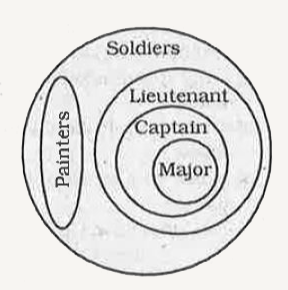For the Venn diagram given below, which of the following conclusion(s)is/are true?

I. Some Captains are painters.
II. Some Lieutenants are painters.
III. All Majors are soldiers.
IV. All Captains are soldiers.
V. All soldiers are painters.
Only I and V follows
Only I, III and IV follows
Only II, IV and V follows
Only III and IV follows
The correct Answer is:D
All Majors are captains. All Majors are Lieutenants. All Majors are Soldiers. (This is Conclusion III) All captains are Soldiers. (This is Conclusion IV). All Lieutenants are Soldiers. All Painters are Soldiers. No Painter is Captain.
Topper's Solved these Questions
- SYLLOGISM, STATEMENT AND CONCLUSIONSBOOK - KIRAN PUBLICATIONCHAPTER - SYLLOGISM, STATEMENT AND CONCLUSIONSEXERCISE - TYPE II
193 Videos
- SERIESBOOK - KIRAN PUBLICATIONCHAPTER - SERIESEXERCISE - TYPE-VI
90 Videos
- SYMBOLS & NOTATIONSBOOK - KIRAN PUBLICATIONCHAPTER - SYMBOLS & NOTATIONSEXERCISE - TYPE-III
38 Videos
Similar Questions
Statements: All kings are warriors.
All soldiers are warriors.
All sentries are warriors.
Some sentries are soldiers.
Conclusions: I. Some sentries are kings.
II. All warriors are soldiers.
III. Some warriors are sentries.
IV. Some soldiers are kings.
1) None follows
2) Only I follows
3) Only II follows
4) Only II and III follows
5) None of these
View SolutionRead the given statements and couclusions carefully. Assuming that the information given ill the statements is true, even if it appears to be at variance with commonly known facts , decide which of the given conclusions logically follow(s) from the statements.
Statements:
I. Some men are animals.
II. All trees are rivers.
III All animals are trees.
Conclusions:
I. Some men are rivers.
II. All rivers are animals.
III. All rivers are men.
IV. All men are trees.
View Solution
Knowledge Check
Statements:
Some carpenters are artists. Some dancers are painters
Conclusions:
I. All artists are dancers
II. All painters are dancersAIf only conclusion I followsBIf only conclusion II followsCIf either conclusion I or conclusion II followsDif neither conclusion I nor conclusion II followsIn the following question below are given some statements followed by some Conclusions. Taking the given statements to be true even if they seem to be at variance from commonly knows facts, read all the Conclusions and then decide which of the given Conclusions logically follows the given statements.
Statements :
I. All insects are dangerous.
II. All machines are dangerous.
Conclusions :
I. All dangerous are insects.
II. All dangerous are machines.
III. Some machines are insects.AOnly Conclusion I follows.BOnly Conclusion Il follows.COnly Conclusion III follows.DNo Conclusion follows.In the following question be low are given some statements followed by some Conclusions. Taking the given statements to be true even if they seem to be at variance from commonly knows facts. read all the Conclusions and then decide which of the given Conclusions logically follows the given statements.
Statements :
I. All Insects are dangerous.
II. All machines are dangerous.
Conclusions :
I. All dangerous are insects.
II. All dangerous are machines.
III. Some machines are insectsAOnly Conclusion I follows.BOnly Conclusion II follows.COnly Conclusion III fol lows.DNo Conclusion follows.
Statements: All students are patriots.
All Indians are patriots.
Conclusions: I Some students are Indians.
II Some Indians are students.
III All Indians are students.
IV. All students are Indians.
View SolutionIn the following questions, two statements are given followed by two conclusions/assumptions, I and II. You have to consider the statement to be true, even if t seems to be at variance from commonly known facts. You are to decide which of the given conclusions/assumption can definitely be drawn from the given statements. Indicate your answer.
Statements :
I. All poets are day dreamers.
II. All painters are day dreamers.
Conclusions :
I. All painters are poets.
II. Some day dreamers are not painters.
View SolutionIn each of the following question below are given some statements followed by some conclusions. Taking the given statements to be true even if they seem to be at variance from commonly known facts, read all the conclusions and then decide which of the given conclusion logically follows the given statements.
Statements:
I. No pens are pencils.
II. No eraser is cup.
III. All pencils are erasers.
Conclusions:
I. Some pens are not erasers.
II. Some erasers are not pens.
III. No pencil is cup.
IV. Some erasers are cups.
View SolutionIn the following question below are given some statements followed by some conclusions based on those statements. Taking the given statements to be true even if they seem to be at variance from commonly known facts. Read all the conclusions and then decide which of the given conclusion logically follows the given statements.
Statements :
I. Some numbers are letters.
II. No letter is water.
Conclusions:
I. Some water are numbers.
II. Some letters are number.
III. All letters are water.
View SolutionStatements: Some pens are cups. No cups are plates.
Conclusions: I. Some pens are not plates. II. All pens are plates. III. Some plates are not pens.
View Solution
